|
– Part 1: The Films –
This fourth Columbia Noir box set from Indicator once again features six film noir titles made by the Columbia studio, this time between the years 1948 and 1957. Well, it does and it doesn’t. There’s an argument to be made that three of the films here are not fully fledged noir titles but films that are shaped in part by its influential branding. Since the definition of what qualifies as film noir seems to vary depending on who’s talking or writing about it, this is without question a personal viewpoint. But in his commentary on the second disc, Frank Krutnik offers up this quote from a source I couldn’t quite make out, one that makes a case for why the semi-documentary format of the first two films in this set do not qualify:
“The documentary considers the murder from without, from the official police viewpoint, the film noir from within, from the criminal’s. The police are omnipresent, so as to intervene or lend an ear. There is none of this in film noir, which is set in a criminal milieu itself. It proposes a psychology of crime.”
He also offers the following definition of the term:
“More purist conceptions of film noir find it difficult to embrace films like Walk East on Beacon!, as they go against the individualism, existentialism, expressionist flamboyance or sexual intrigue that they prefer in noir films.”
And I guess that’s how I like my noir served. That said, all six films here are of definite interest, and all have qualities to recommend them, but three are far better than that faint praise might seem to damn them, and two of those absolutely earn their full noir qualification.
And so, to the films, which I’ve covered in chronological order. Coverage of the sound and vision and the special features of each disc are on page 2.
| WALK A CROOKED MILE (1948) |
|
In Lakeview, California, the home of a key nuclear physics research laboratory, FBI agent Jimmy Colton calls his boss, Daniel O'Hara (Dennis O'Keefe), from a payphone with important news about a man named Anton Radchek (Philip Van Zandt), but is shot dead before he can reveal what he has discovered. Keen to uncover exactly what Colton had on Radcheck, O’Hara and his colleague, Alison (Jimmy Lloyd – Alison is his surname), follow him to San Francisco and keep a close watch on the rooming house in which he is staying, hoping to discover who his contact is. A team of O’Hara’s men use a hidden camera to film every visitor who enters or exits the house and monitor every phone call made from it, and when Radcheck fails to take his usual walk for breakfast one morning, they check his room and find him stabbed through the heart. When reviewing the film that they shot earlier that day, O’Hara quickly realises who the murderer must have been, but none of his colleagues thought to check on him or follow him when he left the building because he was dressed as a clergyman. I presume these dumbasses all skipped the lesson on their FBI training course that explained the concept and purpose of disguises. It’s just as well that Radcheck wasn’t involved in something serious like smuggling American atomic secrets to the Russians. Oh, wait…

O’Hara gets a break when he is introduced to Scotland Yard Detective, Philip 'Scotty' Grayson (Louis Hayward), who’s visiting the FBI after intercepting a painting of a San Francisco skyline that was sent from America to an enemy agent in Britain. When the painting was examined in the Scotland Yard labs, a scientific formula was revealed to have been cleverly worked into the paint pigments, one that could only be seen under ultraviolet light. When the formula is discovered to have originated at the Lakeview Research Centre, O’Hara realises that his and Grayson’s cases are connected, and the two work together to try to identify the man who made the painting, and discover how a formula from a secret nuclear research project was smuggled out of a supposedly secure centre like Lakeview and passed to enemy agents.
Walk a Crooked Mile is very much a film of its time, a post-WW2 America where communist paranoia was in full flow and the country’s frosty relationship with the Soviet Union had initiated what became known as the Cold War. There was widespread belief that all corners of the country had been infiltrated by a massive network of Russian spies, and while the scale was often exaggerated by the authorities, clear evidence emerged that Soviet agents were indeed operating on American soil and had successfully stolen nuclear secrets. What makes many films of the period that were built around this basic premise so hard to digest today is their almost cartoonishly demonic portrayal of enemy agents and the tearfully flag-waving patriotism of the good, clean Americans who bring them to justice. At first, it looks very much as if Walk a Crooked Mile is going to follow that path, with its opening caption saluting the work of the Federal Agents who protect the nation’s top secrets against enemies who “walk their crooked miles along the highways and byways of free America,” which is followed by a pan across the Lakefield Research Centre and comes to rest, with lead-weighted symbolism, on a waving American flag. This, combined with another element of the film that I’ll get to in a minute, had me convinced from the start that I was in for a rough ride. As it turns out, I was to be most pleasantly surprised.
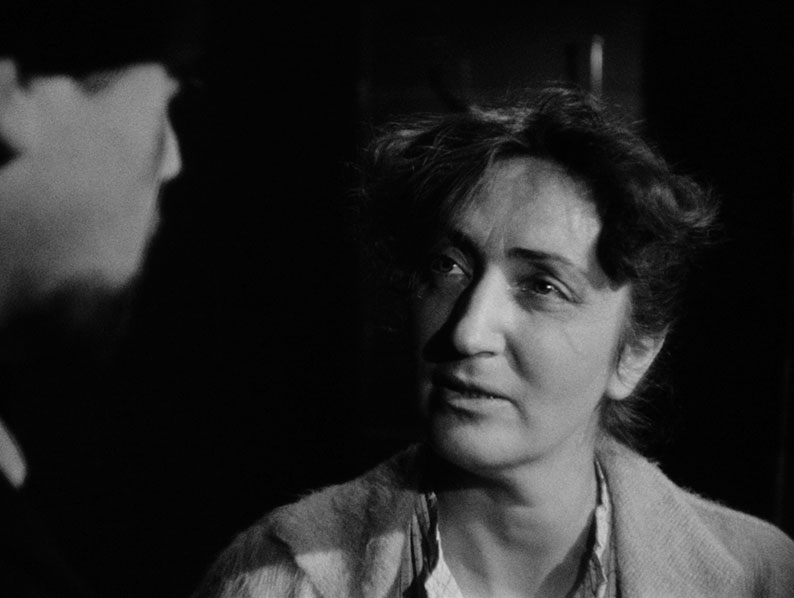
For a start, the enemy agents are not portrayed as two-dimensional villains. Led by a man named Igor Braun (Onslow Stevens) and including in their number a shifty-looking operative named Krebs (an initially unrecognisable Raymond Burr), they are indeed portrayed as ruthless and ideological, but are also shown to be wily operators whose collective ingenuity ensures that O’Hara and Grayson really do have their work cut out for them. Against all expectations, I also came to rather like the lead FBI agent and his Scotland Yard counterpart, and how unexpectedly well they worked as a team. Grayson in particular is played with engaging warmth by Hayward, whose ability to read clues, show resistance under pressure and late-film perfect timing make him someone you’d want at your side when the chips were down. I’d even go as far as to say that I’d happily have watched another couple of adventures with these two as partners, had they ever been made. I also appreciated that problems are shown to be solved by solid investigative work rather than through chance events or convenient hunches. In a particularly well-handled scene that in its gentle way anticipates an electrifying sequence in the later Manhunter, the police FBI forensic scientists have to run a series of tests on material to reveal a possibly hidden formula rather than successfully doing so with the first test they try. Perhaps the strongest sequence revolves around a supporting character, Mrs. Ecko, who responds to the bullying behaviour of Krebs and his associates with a defiant but never overplayed speech about having lost her whole family to men like them, a likely reference to Nazi Germany that is also intended to be read as being about Stalinist Russia, especially given that the criminally uncredited actor Tamara Shayne was born in what was once known as the Russian Empire.
All of which, under the solid direction of the reliable Gordon Douglas, makes for a surprisingly engrossing, level-headed, visually noir-tinted (cinematographer George Robinson loves his dark shadows) and consistently entertaining crime drama. For me, however, there just one annoying bluebottle in the ointment, one that at times comes close to derailing a film that I remain convinced would have been far better without it, and that’s the inclusion of the sort of March of Time-inspired narration that became a bit of a fixture of the semi-documentary thriller format. Apart from providing a few background details on the members of the scientific team whose secrets are being stolen, and filling in the odd piece of plot or character info – all of which could have been achieved either visually or through dialogue – it serves no purpose here, and too often just points out what we can clearly see unfolding on screen. Fortunately its usage is reduced as the film progresses.
| WALK EAST ON BEACON (1952) |
|
Do you ever get hit with an overwhelming sense of déjà-vu? Watch the films in this box set in chronological order, as I did, and there’s a good chance you’ll experience it not long after putting the second disc in the drive. Considering what I initially said about the first film in this set, give a thought to what initially hit me about the second. First, it also has a title that starts with the word ‘Walk’. Okay, no biggie. It also has a serious-voiced narrator who tells us things that could probably be shown of communicated through dialogue. Hmm. Then there’s the plot. Secrets are being stolen from a hush-hush governmental science project and passed to the Soviet Union, and the FBI are working to uncover… wait a damned minute, am I watching a remake of the earlier film? It turns out I’m not, but they’re certainly cut from the same Red Scare paranoia cloth, and this second film is every bit as keen to canonise the work of the fine men (and they’re always men) of the Federal Bureau of Investigation. But where Walk a Crooked Mile confounded my initial expectations for what was about to unfold, in its first third at least, Walk East on Beacon tends to confirm them. There are definitely good things here, but it’s nowhere near as engaging as the earlier film, and it’s certainly less coy about its political viewpoint.
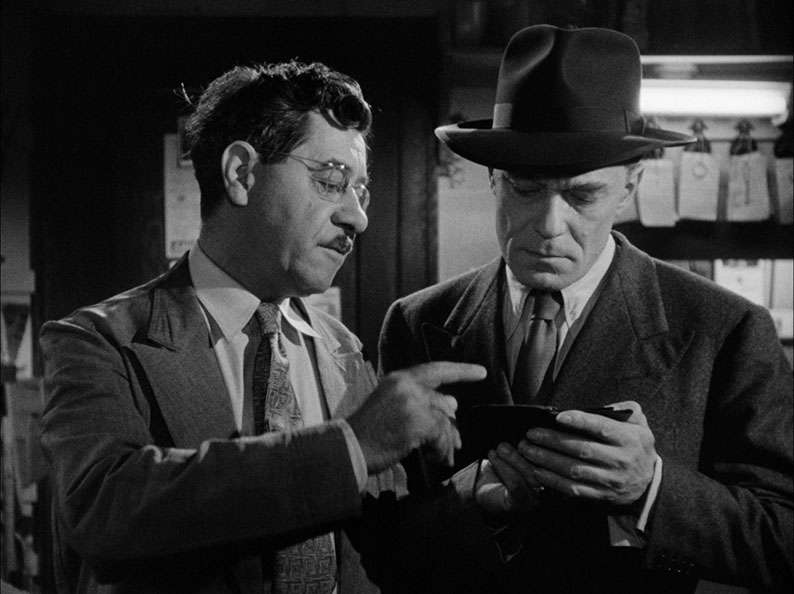
The secret being targeted here is a non-specific mathematical formula that will enable the American scientific community to do all sorts of things that were once thought unachievable, including go into space and use missiles to target anywhere on Earth. I can’t be the only one who was alarmed by that seemingly throwaway line. The formula is being studied and calculated by kindly old Professor Albert Kafer (Finlay Currie), a German immigrant whose son is still stuck in Soviet-run East Berlin. But wait, I’m getting ahead of myself here. The film is initially concerned with an investigation led by FBI Inspector James Belden (George Murphy), one that is triggered when a ‘concerned citizen’ writes to the Bureau after she spotted her husband acting suspiciously. Blimey. As the agents follow clues and shadow suspects, the narrator is fed the odd unintentionally comical line (“Police already knew many suspected communists with shoulder bags”) and the investigation eventually points the team towards Gregory Lazchenkov (Karel Stepanek), who unbeknown to them is a key Boston-based communist agent who has been tasked with arranging the theft of the mathematical formula that the aforementioned Professor Kafer is working on.
Before I go any further, I should note that the mechanics of how this operation is conducted are of very real interest, and having been made with the cooperation and input of the FBI, I have to assume that there is a degree of authenticity to what is being portrayed. The film certain certainly plays at times like a documentary, albeit one in which supporting toles are played by actual FBI employees, usually ones with no visible acting talent. The real problem, however, is that unlike the likeable duo of O’Hara and Grayson in Walk a Crooked Mile, the lead FBI agents here are the dullest and least charismatic law enforcement officials I’ve seen in a film in some time. There’s even a moment when the agents are targeted with hunting out a suspect named Robert Martin (Ernest Graves), and gather round a life-sized cardboard cut-out of him in order to familiarise themselves with his appearance (wouldn’t a photo or a sketch do just as well?), and I momentarily had trouble telling the agents apart from the facsimile.
By contrast, Lazchenkov and his operatives are more fleshed out as characters and their activities more intriguing. They include in their number flower shop owner and sleeper cell organiser Luther Danzig (Bruno Wick), and taxi driver Malvin Foss (Jack Manning), a reluctant recruit whose past membership of the Communist Party is now being used to blackmail him into following Danzig’s orders. It’s in the backstory of Foss – who is well played by Manning – that the film’s propagandist overtones are most blatantly evident, the suggestion being that anyone who even flirted with the notion of communism is now a potential enemy of everything free Americans hold dear. It’s this exact ideology that fuelled the activities of the House of Un-American Activities Committee hearings, which saw the lives and careers of some of the most talented men and women in Hollywood destroyed, usually because they once opposed fascism and believe in a political philosophy that they subsequently abandoned. And while we’re on the subject, if you fancy turning the film into a drinking game, then take a shot every time the word “communist” is uttered and you’ll likely end up on the floor in an alcoholic coma.

Only with the arrival in the story of Professor Kafer do the forces of light get a character I was able to engage with, and by then revolving the narrative primarily around him and the attempt to blackmail him using his son as leverage, the film gets a welcome second-act lift that it largely sustains until a climactic pursuit that I found it hard to get excited by. Oddly, given its propagandist intentions, the film is at its best when it’s focussed on the activities of the would-be saboteurs, who in the manner of the monsters in so many memorable horror films of the 1930s, are far more interesting than the dullards who seek to expose and destroy them. That said, I’d sure like to know more about the video camera that the FBI tech boys use to spy on the flower shop, as at a time when you could clearly see the lines that made up a TV picture, this device could produce a clear HD quality image, and despite small size, it appears to have a battery life that the makers of modern mobile phones and action cameras would kill for.
Now you’re talking.
If classifying the first two films in this set as film noir could be called into question, no such claim is likely to be made about the 1954 Pushover, which had my full attention from its opening frames. As a bank security guard arrives at work one morning, a man sidles up behind him and sticks a gun in his back. As the two enter, the gunman is joined by a well-dressed partner, whom we later discover is a hoodlum named Harry Wheeler (Paul Richards). He unlocks the front doors and sits down to patiently wait for the staff to turn up for work, who are wordlessly held at gunpoint until the arrival of the manager, who is directed to open the vault and allow the men to rob it of $210,000 (which according to my calculations is equivalent to just over $2 million today). As Wheeler is leaving the vault with the cash, however, the security guard makes a grab for other man’s gun and is immediately shot dead by Wheeler, which prompts the two robbers to make a very quick getaway. And so concludes one hell of a title sequence, one in which a story is told clearly without a word of dialogue.
It’s then that we meet the glamorous Lona McLane, played in her first feature role by Kim Novak, and this is one of those films where you can see a star being born from the moment she exits a theatre and walks towards the camera. When she reaches her car, the damned thing won’t start, but fortunately for her, Paul Sheridan (Fred MacMurray) just happens to be passing. He suggests that she may have flooded the engine and gives it a try. When it still won’t start, he takes a look under the hood and spots a problem with the spark plugs, one that will require the attention of a mechanic. It all sounds very cordial, but you don’t know the half of it. From the moment Paul appears at the window of Lona’s car, his every word and look tells us that he has the hots for Lona. It’s not hard to see why. Novak is not only radiantly beautiful here, she seems every bit as attracted to Paul and makes no attempt to conceal it, delivering almost every line as a thinly coded come-on. The two head to a bar to call a mechanic, and when the repair looks like taking them past closing time, Lona asks Paul if he’d like to take her home, and does so with a look and a vocal intonation that plays like an open invitation. “You’re place or mine?” asks Paul, to which Lona seductively replies, “Surprise me.” They go to Paul’s apartment, where the sexual tension continues to sparkle, and the two end up locking lips on the sofa into a fade-out that suggests it didn’t stop there.

At this point, I had made a couple of assumptions, both based on the genre into which this film comfortably sits. The first was that Paul’s attraction to Lona was going to land him in trouble. In noir, leading men and glamorous leading women rarely enter into lust-triggered relationships that result in a long-lasting marriage and kids. The second assumption was that if this scene was connected to the opening robbery – and logic dictates that it somehow had to be – then Paul was likely being set up for a fall of some kind by Lona, whom I suspected was Wheeler’s girlfriend and under orders to seduce this man for an as-yet unspecified reason. It’s a suspicion that I’ll freely admit was underlined by the casting of Fred McMurray in a part that has undeniable echoes of his role as insurance salesman Walter Neff in that granddaddy of noir thrillers, Double Indemnity. That both Kim Novak and the earlier film’s Barbara Stanwyck play seductive blondes with a nice line in suggestive dialogue only adds to this perception. In retrospect, I can’t help thinking that screenwriter Roy Huggins and director Richard Quine had this in mind when they planned out the scene.
We then jump ahead three days and meet Police Lt. Carl Eckstrom (E.G. Marshall) as he expresses frustration at his department’s inability to locate Wheeler and the progress made by his two detectives, Rick McAllister (Philip Carey) and the older Paddy Dolan (Allen Nourse). Then, out of the blue, Paul casually strolls into the room. “About time you showed,” says Eckstrom, and when Paul admits he has nothing definite to tell him yet, Eckstrom responds, “What do you want? Another three days with her?” Okay, you got me. I’ll freely admit that I was most effectively misdirected. Where I was on the money is that Paul has become convinced that Lona is Wheeler’s girl, a deduction made from her behaviour rather than anything she’s said. Eckstrom thus elects to set up a stakeout in an apartment directly across from Lona’s own, with two detectives watching at all times so that one of them can tail Lona whenever she leaves while the other remains to keep their eye on the apartment in case Wheeler shows. When Lona pops out while Paul and Rick are on stakeout duty, Paul follows at a distance and ends up tailing her back to his apartment. Here she reveals not only that she’s sussed that it was Paul who meddled with her car that first day, but also that she now knows that he is a cop. The two end up in a fight that dissolves into an embrace and a passionate kiss. Paul then reveals the purpose of his mission, but also that his involvement with Lona has gone beyond the call of duty. It’s then that Lona starts musing on what the two of them could do with all that stolen money if Wheeler showed up and was killed…
Right, before I talk about why I was riveted by Pushover, let’s get the more implausible elements of the setup out of the way. That the police would do whatever they could to catch a murderous bank robber is understandable, but whether an even adventurous Lieutenant would give one of his detectives the job of seducing and probably sleeping with a woman on the off-chance that she might be the girlfriend of the man they are seeking is a whole different matter. Even so, the success of the plan would rely heavily on Lona being willing to cheat on her hardened criminal boyfriend, and being instantly and irresistibly attracted to a man who is old enough to be her father and not exactly blessed with matinee idol looks. It takes some swallowing. But this is film noir, a genre (or a style, take your pick) in which such things happen, and we tend to accept them because of where they ultimately lead. And on this score, Pushover is a bit of a belter.
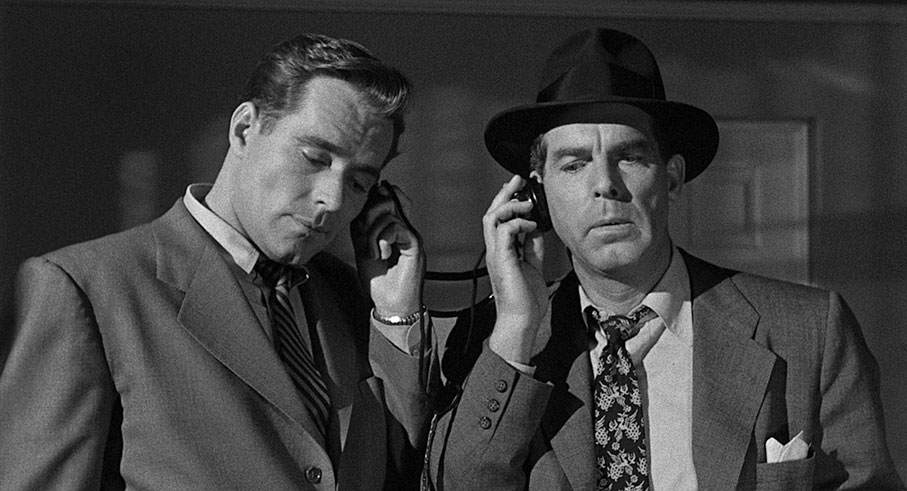
First of all, despite that sizeable age gap, Fred McMurray and Kim Novak prove to be perfect casting in the leads, with MacMurray’s smart-talking tough guy Paul nicely counterbalanced by the red-hot sexuality of Novak’s Lona, whose allure is emphasised at every step by the framing and lighting of Lester White’s often gorgeous monochrome cinematography. The two leads spark wonderfully off each other, and while their relationship feels doomed from the moment Paul agrees to go along with Lona’s plan, you keep hoping against hope that they’ll pull back from the brink and find a way out of the increasingly convoluted mess in which they find themselves mired. The film also benefits greatly from having policemen who behave like experienced detectives and who know each other well enough not to be fooled by stories and actions that in lesser movies would distract them or send them on wild goose chases. Deserving of special mention here is old hand Paddy Dolan and Lieutenant Eckstrom, both of whom accurately read situations that tradition has primed us to expect them to be misled by, which in one case results in a tragedy that complicates things further for the already up-to-his-neck-in-it Paul. This multiplying of complications to an ill-thought-though plan also leads to some splendidly effective wind-ups and makes inventive use of an apartment block whose horseshoe layout places the watchers, their target and their target’s immediate neighbour in the same building. This is developed further when Rick takes an interest in Lona’s attractive neighbour Ann (Dorothy Malone), whom he first spots hanging curtains that she only closes when the story requires her to do so (one of my partner’s pet peeves is that Americans in movies always seem to fill their homes with light at night but never close the curtains). That he is first attracted to her whilst surreptitiously spying on her from across the way has voyeuristic overtones whose creepiness is upped a notch by Rick’s earlier expressed misogyny, and were it not for the fact that the two films were in production at the same time, I’d be suggesting a link to Hitchcock’s Rear Window.
For me, Pushover is easily one of the standout films in this set, a tightly and intelligently plotted and convincingly performed noir thriller that sees actor-turned-director Richard Quine at the top of his game. Despite a couple of required but easy-to-make plausibility jumps, it unfolds compellingly, piling on the twists and complications in a manner that never strains credibility and had me metaphorically chewing my nails, despite knowing from an early stage that Paul and Lona’s plan would likely not work out well for either party. It also comes to a most satisfactory conclusion, one that leaves us with plenty to ponder on but gives its lead characters the final moments they by this point absolutely deserve.
| A BULLET IS WAITING (1954) |
|
The 1954 A Bullet is Waiting opens with a budget-saving piece of visual exposition that I can’t help but salute. A wide shot of a rugged shoreline gives way to a closer framed pan across the tide as it hits the shore, settling on what I instantly recognised as the wheel of a light aircraft, one I thus knew instantly had recently crashed there without having to be shown the accident itself. After moving back to reveal more debris, the camera switches to the image of two men punching the living crap out each other. It’s initially shot wide, but even at this distance I could clearly see that they were handcuffed to each other. When one knocks the other out, he immediately digs through the second man’s pockets to find the key required to unlock the handcuffs, then heads immediately off. Thus, without a word of dialogue, we’ve been told that that the unconscious man is likely an officer of the law, that the one currently making his escape was his prisoner, and that the two are survivors of the inferred plane crash.
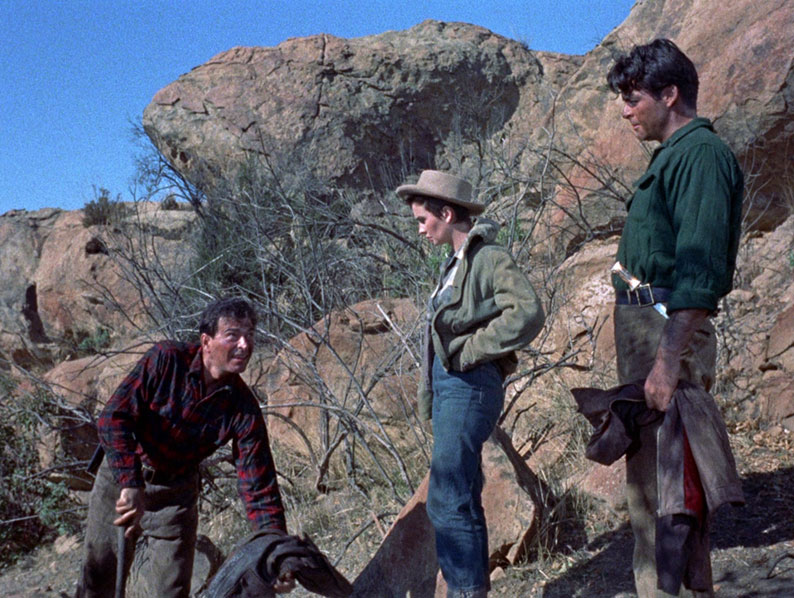
The prisoner doesn’t get far before encountering the young Cally Canham (Jean Simmons), who appears before him with a rifle and her protective sheepdog, Shep, and demands to know what this stranger is doing on her land. A short while later, the now revived but injured law officer drags himself onto the scene (quite how he climbed the steep hill so quickly with a supposedly crippling injury is beyond me) and introduces himself as Sheriff Frank Munson (Stephen McNally), identifying the other man as his prisoner, Ed Stone (Rory Calhoun). He tells Cally that he arrested Stone that morning in Arizona and was flying him to Los Angeles when the light aircraft in which they were travelling ran into trouble and crashed, killing the pilot and breaking Munson’s ankle. Stone throws a little doubt on Munson’s story by suggesting that Cally ask to see his badge, which Munson then claims that Stone has stolen. Stone wants directions to the nearest town, but Cally tells the men that neither of them are going anywhere until they get their stories straightened out. She thus leads them back to the isolated farm in which she lives with her father David (Brian Aherne), who is currently away on a bit of a bender and is not expected back home that evening. It’s here that Munson reveals to Cally that the crime Stone has been arrested for is murder.
A heavy downpour traps both men in the house overnight, but the following morning Cally rises to discover that Stone has taken some supplies and departed. She catches him up before he gets too far, his way out having been barred by the snarling, barking Shep. Reluctantly, Cally agrees to show him the way, but warns that it usually takes days for the water levels to subside to a navigable level in the pass that is the only route in and out of this region. After aggressively trying it on with a thankfully resistant Cally, Stone heads off anyway, only to end up slipping and falling into a raging river and subsequently returning to the relative safety of the farm. As Stone questions Cally’s seemingly enforced isolation and Cally takes an interest in this apparently dangerous stranger, the truth about his crime and Munson’s two-year pursuit of him starts to emerge.
If you find yourself questioning the noir credentials of the first two films in this set, wait until you get to A Bullet is Waiting. For a start, it’s in colour, and while there are colour films that earn their noir classification, they are in a minority and tend to compensate for the lack of those signature monochrome visuals through the darkness of their plot, tone and characters. Roger Ebert nailed it nicely when he drew up a list of the defining elements of film noir and included, “Movies either shot in black and white, or feeling like they were.” That’s never the case with A Bullet is Waiting, which visually has the look and feel of a 1950s western. I would even argue that it plays a bit like one, right down to the role played by the landscape, the farmhouse location, the clothing worn by the main characters, and a plot involving a sheriff and his prisoner that climaxes in a shootout. On the commentary track, Kim Newman notes that some people misremember the film as a western. Frankly, I’m not surprised.
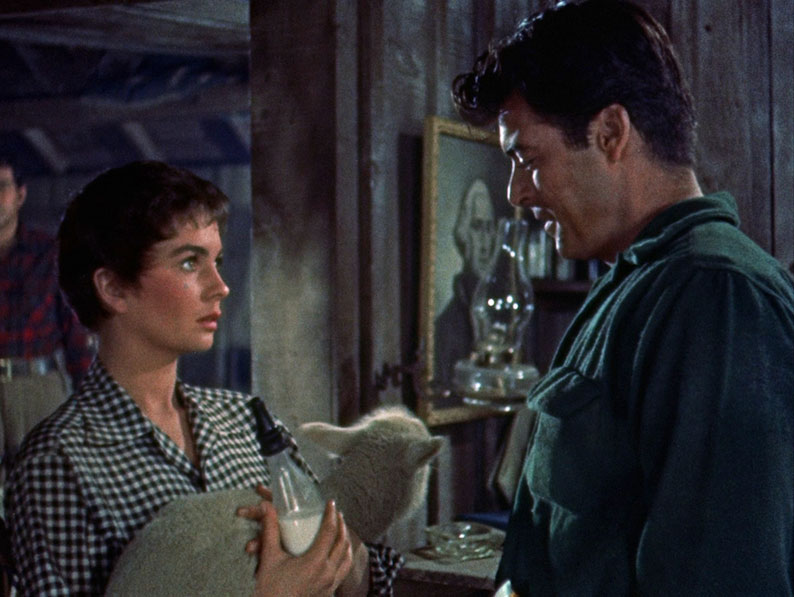
As has been stated elsewhere (and is explored more in the commentary), there’s more than a whiff of Shakespeare’s The Tempest to the setup, and it soon becomes clear that the film is ultimately going to be less about Stone’s conflict with Munson and more about his developing relationship with Cally. It’s a case of good-looking bad boy meets young and attractive female innocent, a girl that has lived a sheltered and isolated life who is destined to undergo a sexual awakening at the hands of a wild man that her good nature may help to tame. That’s not to say the road to that point is going to be a smoothly paved one. At first, Stone is less interested in Cally than in her rifle and her knowledge of the terrain, and the first advance he makes towards her is nothing short of attempted rape. This occurs at an interesting point in the narrative, one in which I was starting to suspect that Stone was not quite the dangerous killer that Munson had been painting him as, yet in that one move against the shocked and resistant Cally, I lost all sympathy for him, and when he subsequently takes the tumble into the river (a risky stunt that looks like it was performed by Calhoun himself), a part of me was rather hoping that he’d drowned. This sequence also casts a bit of a shadow over the subsequent scenes in which he and Cally develop genuine feelings for each other, as however genuine they may be, the very notion that an attempted sexual assault might unlock suppressed emotions in a woman is riddled with problems. It also raises a couple of questions about the past actions of a man who we can presume has tried this tactic before and possibly seen it through to its unpleasant conclusion. He may alternatively have elicited a more positive response from the previous target of his actions, which would perhaps explain why he eventually backs off and takes his leave when Cally continues to angrily resist. It’s not the only inferred but unanswered question about the backstories of the two men, the details of which are never fleshed out but whose personal histories undergo a couple of interesting factual and perceptual shifts during the course of the film.
Whether any of this earns the film the noir credentials it’s been afforded through inclusion in the box set is another matter. As the venerable Mr. Newman suggests in the commentary, the only aspect of the film that really qualities is the character of Munson, whose determination to bring Stone to justice is revealed to be driven less by his sense of duty as a lawman than a very personal quest for vengeance. Intriguingly and just a tad frustratingly, the truth about this particular back story is never confirmed either way. By the final scenes we’ve been steered to who to root for, but interestingly not at the expense of the other, which takes the edge of a climactic conflict that you just know will have to conclude with the sort of amicability that a pure noir movie would look down on with scorn. Not helping matters is the return of Cally’s father, which instigates a finale that plays out and concludes in a manner that sacrifices credibility for smiles-all-round tidiness.
But if you can put the supposed noir classification aside and see the film for the drama of relationships and sexual awakening that it technically is, there are some definite pleasures here, notably in the lead performances, some intriguing subtextual elements, and aspects of old hand John Farrow’s direction. Come to it expecting a darkly cynical, old-school noir thriller in the manner of Pushover, however, you may well find yourself wondering just what the hell you’ve stumbled into. Great noir title, though.
In 1950s Chicago, following the fall of notorious gangsters like Al Capone, the only Mob boss still active is Arnie Valent (Paul Stewart), who conceals his criminal activities behind a string of legitimate businesses. Immediately after his bookkeeper, Nelson Kern, has visited newspaper editor David Healey (Richard H. Cutting) claiming to have proof of Valent’s criminal ventures, he is gunned down in the street, the news of which drives his wife to suicide and their Paris-based daughter into a Swiss sanitorium. Determined to find a way to bring Valent to justice, Healey assembles a group consisting of wealthy businessmen, the deceased man’s lawyer, a detective with experience fighting the Mob, and a crime-busting state attorney, the aim being to plant a man inside Valent’s organisation who could gain his trust and seek out the evidence that Kern had claimed to have. The individual they have selected is ambitious accountant and former war hero, Barry Amsterdam (Dennis O'Keefe), whom they hope to persuade to take the job by offering him payment of $60,000 (that would be over $600,000 today), which would enable him to set up his own accounting business. Initially reluctant to put his life at risk, he is eventually persuaded and takes his first steps towards ingratiating himself with the head of the city’s largest and most dangerous criminal gang.
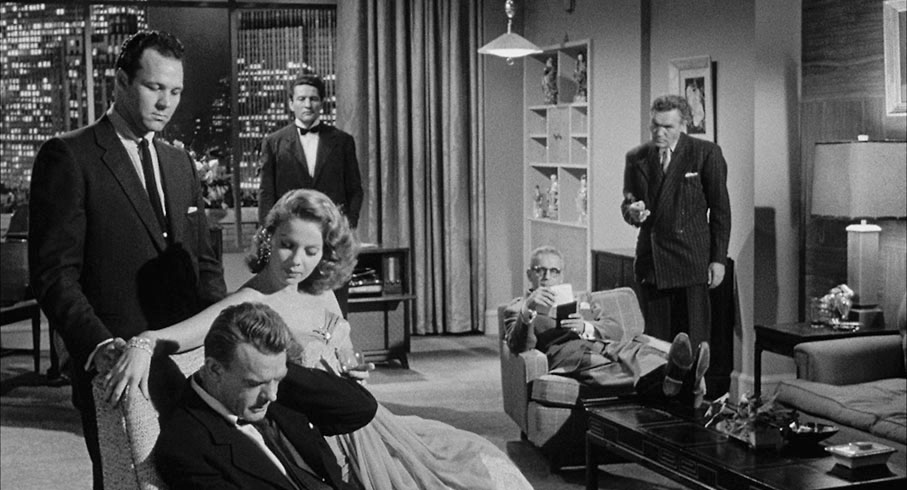
Chicago Syndicate starts efficiently, if a little unadventurously, with a montage of stock footage – including a newsreel shot of the real Al Capone – before focusing on David Healey, who effectively introduces himself by virtue of delivering this film’s narration, which is certainly easier on the tolerance than the one that plonks its way through Walk a Crooked Mile. Healey himself is less enthralling than his voice might suggest, and I was just starting to worry that we might be stuck with him when Barry Amsterdam enters the story and proves to be considerably more engaging and animated. His initial reluctance to take the job makes complete sense, but once he accepts, he takes to it like an eager lifeguard to water. Indeed, there were plenty of times when I figured he’d be better off chucking the accountancy game and setting himself up as a private eye. So confident of himself is he and so handy with his fists when the need arises that I had to keep reminding myself that this probably had more to do with his wartime service than anything he learned at bookkeeping school.
For the most part, Barry’s recruitment by Valent and rise though his organisation to a position of trust is believably handled. I particularly liked his sneaky method for gaining entrance to one of Valent’s backroom gambling dens, although a little belief suspension is required to swallow his risky and chance-reliant plan to wheedle is way into first meeting this heavily protected mobster. Once installed in the organisation’s accounting department, however, credibility is restored by his willingness to bide his time, and a nicely engineered wheeze to save the insurance company Valent uses as a front some money. He’s also savvy enough to realise that the two cops who pay him a visit and attempt to beat information out of him have been sent by Valent as a final integrity test, one he passes with flying colours by keeping his mouth shut, knocking them both cold and directly confronting Valent about the incident. Especially pleasing, primarily because it kicks against tradition and expectation, is that Barry does not become romantically involved with either of the attractive women he meets during the course of his operation, largely because neither seem all that impressed with him. His pestering of Sue Morton (Allison Hayes) – including using her to gain entrance to the gambling den – repeatedly elicits a frosty response, while Valent’s young singer girlfriend Connie (Abbe Lane) develops an increasing dislike for him when Valent starts paying more attention to him than to her. Things do complicate with both women, though not in the expected ways, and I see no good reason to reveal more about that here.
Some savvy casting and solid direction from Fred F. Sears (whose later work for this film’s uncredited producer, Sam Katzman, includes Earth vs. the Flying Saucers and Rock Around the Clock) help to sell Valent and his mob as a genuine threat. Leading the pack is the every-reliable Paul Stewart, who excels as Valent, exuding an air of complete authority convincing as a man who could shoot you or beat you senseless on a whim, but is secure in the knowledge that he has people who will do that for him. And the people in question are genuinely intimidating heavies who look more like professional bruisers than actors. When Barry wakes after being slugged and dragged off to meet Valent, the sight of them standing ominously watching him as Connie playfully wafts a reviving brandy under his nose made me genuinely fear for his safety and physical wellbeing. Later, when Valent has two of them take Connie into a side room to beat information out of her, and the combination of her screams, the sharp crack of the slaps and punches and the fact that they’re being administered by two of these goons, makes the scene almost unbearable to sit through, despite the fact that the violence is happening off-screen.
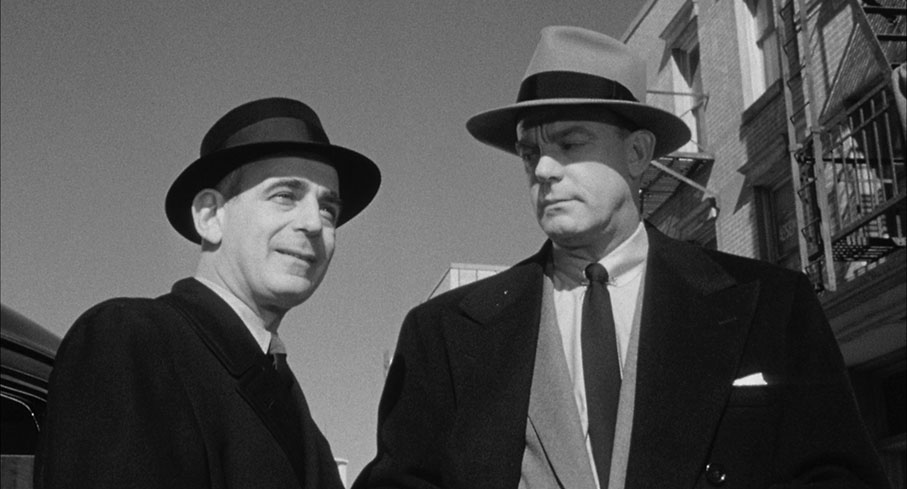
The default level of tension that is created by having a likeable character go undercover in a potentially life-threatening situation is carefully rationed but effectively employed here, with Barry twice coming within a whisper of being exposed and only saved by some smart but believable quick thinking on the part of himself or an ally. It builds to a traditional chase climax, but even here Sears and his team give the sequence a distinctive look by taking the characters down into tunnels beneath the Chicago streets that I would never have known were real fixtures were it not for commentary track on this disc. It makes for a solid finale to a well written, terrifically performed and impressively directed lesson in how to break the rule I quoted at the top of this review and successfully incorporate noir elements into a story that is told from the viewpoint of those looking to bust crime rather than those who have been inadvertently drawn into it.
Of all of the films in this latest Columbia Noir box set, none wound me up more than the 1957 The Brothers Rico. That’s not meant as a complaint – well, except for one bit that I’ll dance around later – but an indication of just how tensed-up I became by the events that unfold. I genuinely can’t pin down exactly why this hit me so much harder than, say, Johnny’s downward spiral in Pushover, but the clues are definitely not hard to spot. Some shouldn’t be discussed in a review that will be read by anyone who has yet to see the film for the first time, but it’s hard to completely bypass them, and so for the first time in this set I may have to throw out a spoiler warning later.
Eddie Rico (Richard Conte) is the wealthy owner of a successful laundry business in Florida, and for ten years has been happily married to the beautiful Alice (Dianne Foster). As the film begins, we’re shown just how fond they are of each other (I’m convinced that if the film was made today there would be a steamy sex scene here). We’re also economically clued in to the fact that Alice cannot have children – the inference is that she has had two miscarriages – and that she and Eddie are waiting for a letter from the orphanage approving their application to adopt a child. Hanging over this is a phone call that Eddie receives late at night from an old acquaintance named Phil (Paul Dubov), informing him that they – whoever ‘they’ are – will be sending him someone that they want him to hide somewhere deep within his organisation. From the conversations between Eddie and Alice that follow, we are able to surmise that Eddie previously worked for the Mob, a life he left when he met and married Alice, and that any hint of trouble with his former associates might scupper their chances of adopting. Adding to Eddie’s concern is a letter from his mother (Argentina Brunetti) expressing her concern that his two brothers have had to go away for unspecified reasons. We’ll be hearing more about that soon.
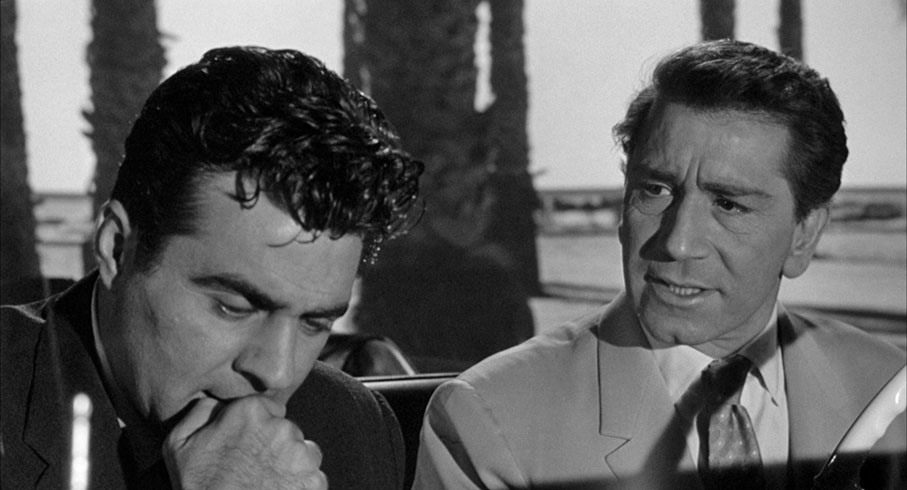
When Eddie gets to work the following day, he finds a man named Joe Wesson (William Phipps) casually leafing through the papers in his office. Eddie clearly has no time for this hood, whom he confirms is the man who was sent to him by Phil and thus puts him to work in the boiler room. I was utterly convinced that this smug, self-satisfied goon would prove to be a human Chekov’s Gun that would go off at the most inappropriate time for Eddie and Alice, but screenwriters Lewis Meltzer and Ben Perry (adapting a novel by Maigret author by Georges Simenon, and with uncredited input from a blacklisted Dalton Trumbo) and director Phil Karlson have other plans for him.
The first real inkling of the trouble that Eddie is soon to face comes when his car is gently bumped by another that has been following him since he left his office. When Eddie turns around, the driver of the car behind signals him to say nothing and pull off to the right, a request that Eddie unexpectedly complies with. Every bit as surprising is that when the two cars pull up to the side of the road, the second man hops into the passenger seat of Eddie’s vehicle, and after looking around nervously for possible witnesses, tells Eddie to drive on, and without saying a word, Eddie complies. What, I wondered, is going on here? All is revealed when Eddie asks the other man, “Gino, what are you doing down here?” and Gino (Paul Picerni) responds, “Eddie, did you hear anything about our kid brother?” It turns out that Gino still works for the Mob and was the gunman in a well-publicised hit on which kid brother Johnny was the driver. Johnny has since disappeared and now there’s talk of a Special Grand Jury investigation, and suddenly everyone’s pressuring Gino to tell them where Johnny is. Gino wants Eddie’s help to flee the country and while Eddie claims Mob boss Sid Kubik (Larry Gates) will take care of him, Gino claims he doesn’t trust him anymore, a proclamation that the startled Eddie can’t believe he’s hearing. He gives Gino some cash and advises him to go to St. Louis as ordered and wait until things cool down a bit while he tries to work something out. When he returns to the office, however, he gets another call from Phil, this time telling him to fly to Miami immediately to meet with Kubik, orders that Eddie feels compelled to follow but that infuriate Alice, who reminds him that the orphanage called to tell them that they could collect their baby today but that both of them need to be there to sign the papers. Eddie assures that he’ll be back as soon as he can, unaware that when he is reunited with the welcoming Kubik, a rather different destiny awaits him.
Believe it or not, the above is effectively all setup for the story that subsequently unfolds, and if you want to avoid even a whiff of spoilers, which are likely to increase in severity as I progress, this is the time to proceed with caution or hop forward to the final paragraph or click here.
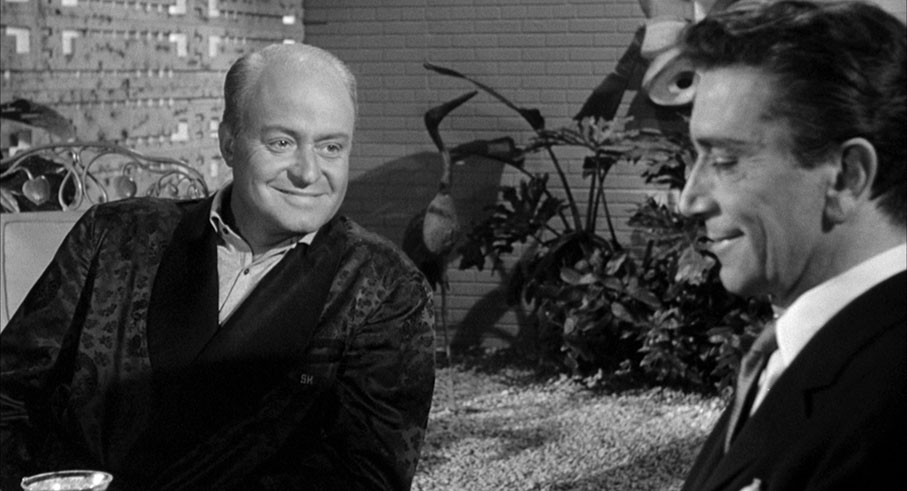
Anyway, after exchanging warm pleasantries, Kubik asks Eddie if he’s heard from Johnny and then sings the praises of Eddie’s mother, stating that he owes all he is and has to her because of something that she did for him years ago. He talks a lot about the importance of family, and states with apparent sincerity as he points at his heart, “My name is Kubik, but in here I’m a Rico.” Kubik then reveals, to Eddie’s genuine surprise, that Johnny is now married to a girl named Norah (Kathryn Grant), whose brother, Peter Malaks (played by later director of note, Lamont Johnson), has apparently been having meetings with the District Attorney. The concern is that his sister might persuade Johnny to turn State’s evidence, which has triggered alarm bells within the organisation. Some want Johnny dead, but due to his close association with the Rico family, Kubik tasks Eddie with the job of finding Johnny, giving him $10,000 with which to persuade his brother to leave the country.
Now, I don’t know about you, but in spite of Kubik’s friendly demeanour and his seemingly sincere reverence for Eddie’s mother, I smelt a large and unsavoury rat here. Maybe it’s the decades of crime movies that followed, or the fact that the film carries a noir label, but when a Mob boss wants to find a person who could be dangerous to his organisation and claims he wants to help him relocate to somewhere safe, he usually has something very different in mind. Anyone remember what happened after Michael Corleone made similar assurances to the terrified Carlo at the end of The Godfather? Impressively, the filmmakers are ahead of us here, and presumably aware that we would work this out they unexpectedly stay with Kubik after Eddie departs and follow him to a room just down the hall, where Gino is tied to a chair and being violently beaten for information on Johnny’s location by two of Kubik’s men. In the space of a few seconds – and full marks to actor Larry Gates on this score – Kubik goes from being a friendly old uncle to the epitome of gangland malevolence. It’s the first of the film’s two “oh shit!” moments, the second of which genuinely had me squirming in my seat. I’m not going to get into the specifics, but the later one really does deliver one hell of an emotional gut punch, and is the point at which my building discomfort hit an almost unbearable peak.
The thing that really started the windup for me is that, despite my quick realisation that Kubik wants to locate Johnny to have him rubbed out, this somehow never seems to dawn on the spectacularly naïve Eddie. Sure, he worked for the Mob as an accountant and not hired gun, and it seems clear that Kubik’s friendliness to him and his family was always genuine in the past and is something that Eddie has come to (mis-) trust as a permanent state of affairs. But in the criminal underworld, the ties of friendship only get you so far, and they will always ultimately be secondary to business. Put simply, if the organisation feels threatened, then all previous bets are off. The likeable Eddie thus goes from being a loyal and concerned brother to one who is unwittingly contributing to the potential murder of both of his siblings, which is made all the more painful by the assurance he makes to each of them at crucial moments, “Did I ever steer you wrong?” Repeatedly, I found myself wanting to step into the screen and slap some sense into him, and by the time the truth dawns on him – a truth that has to be almost shouted into his ears and beaten into his brain – the damage is potentially well and truly done. What’s particularly tortuous is that the film doesn’t end there. Instead the film takes time to rub the consequences of his actions into Eddie’s emotionally distraught brain, as he sits in a hotel room with his guardians, stripped of any hint of control and reduced to pleading with California Mob boss Mike Lamotta (Harry Bellaver) to grant him a favour that he surely knows deep down that the man will simply not respond to. It’s a real strength of The Brothers Rico that it so effectively strips the world of organised crime of any hint of glamour and updates it for the corporate age. Here, the Mob is structured like a nationwide business empire run by ruthless white collar criminals, one whose spread is so wide that there is no city, no hotel, no bank that you can visit without falling under the gaze of its seemingly endless source of loyal criminal eyes.

There’s just one thing, and it’s one that others will have no problem with, but seriously, what the hell is going on with that ending? Everything about it screams studio interference, and for all my desire for relief from the emotional punishment that the film had dished out over the preceding hour, this misplaced attempt to deliver an upbeat conclusion feels like it’s been tagged on as a post-test screening afterthought. It arrives out of nowhere in the shape of that old favourite lightning wrap-up trick of a “THIS HAPPENED” newspaper headline, which is followed by a sequence that requires us to forget all of the pain and suffering that has been inflicted and smile happily at the thought that at least someone got what they wanted. Had the film taken a little more time to explore the emotional consequences of all that has unfolded and eased us more gently into this scene, then I might just have bought it. But arriving suddenly out of nowhere and occupying less than 90 seconds of screen time (look, by contrast, at the time taken at the start to establish the strength and lasting vitality of Eddie and Alice’s relationship), it feels more like a forced appendage than a fluidly arrived-at finale.
But if you can put this aside, as I also had to with the studio enforced ending of the otherwise brilliant Nightmare Alley, then The Brothers Rico is one of the most emotionally punishing noirs of its day, an impeccably cast, compellingly acted, smartly scripted and tightly directed story of how a man is forced to choose between his biological and surrogate families and whose naivety leads him to inadvertently betray the ones he loves. If I had to choose a favourite in this set, then I’d probably still have to go with Pushover, but I have little doubt that in the weeks to come, it’s The Brothers Rico that will probably haunt me the most.
Part 2: Tech Specs, Special Features and Summary >>
|